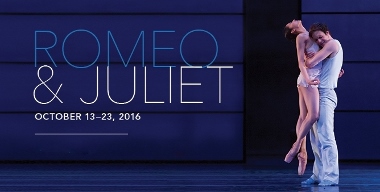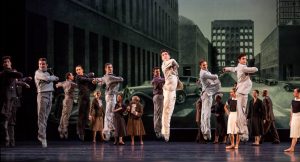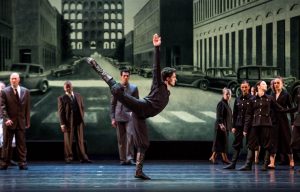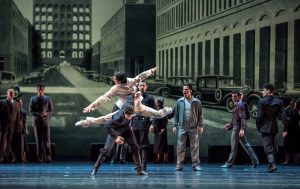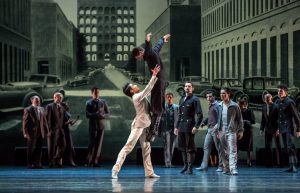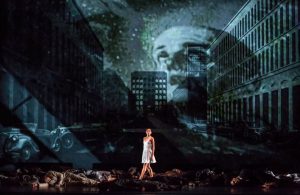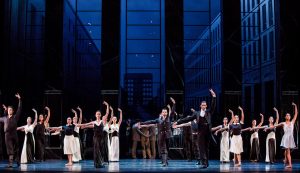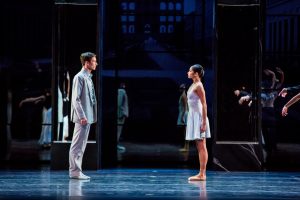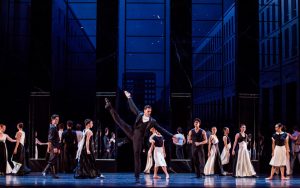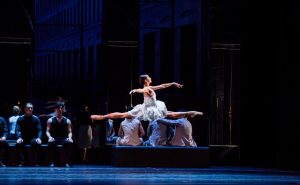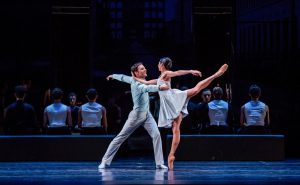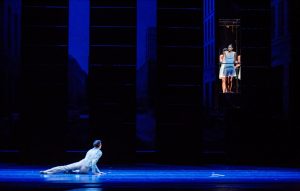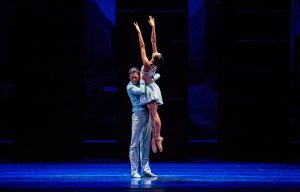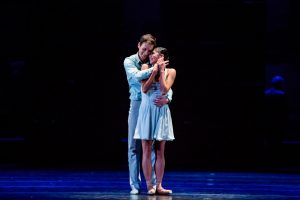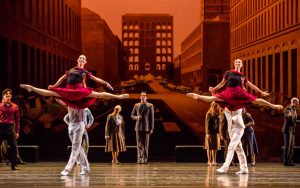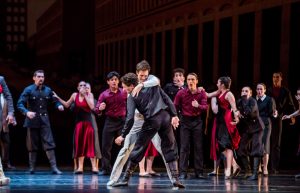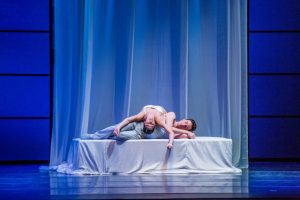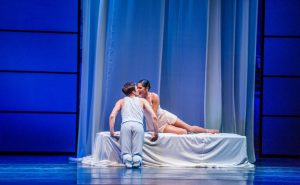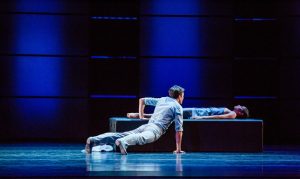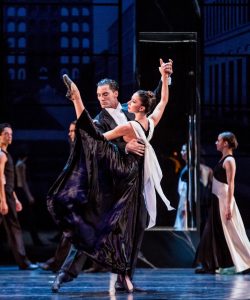A POLITICAL PROKOFIEV
BRINGS R & J CLOSER TO HOME
It’s been over two years since its Joffrey Ballet—and U.S.–premiere. The Chicago troupe’s updated version of Prokofiev’s Romeo and Juliet again re-roots the lovers in modernistic postwar Italy. Slick and lean, this literally black-and-white world (with a little maroon thrown in to suggest blood as much as life) is beset with unfinished business—the festering rancor of Mussolini’s black-shirted fascist thugs (the Capulets) against the carefree and celebratory successful resistance (the Montagues).
As I noted then, this is not your usual Romeo and Juliet, neither the traditional ballet nor the Bard’s doomed romance. Truncated and concentrated, Joffrey’s fierce take on Krzysztof Pastor’s two-act treatment carries no Renaissance finery, just unflinching immediacy. Premiered by the Scottish Ballet in 2008, this muscular treatment of ancient Verona isolates the lovers all the more. They’re the one soft touch in a hate state run by implacably opposed clans who do not seem reconciled by the tragic end.
As for moving the lovers’ liebestod from the 16th century to the Eisenhower Era, aesthetically speaking, it feels more faithful. Given a Renaissance setting, Prokofiev’s music was already instantly anachronistic when first presented in 1938. (Shakespeare, of course, kept it relatively contemporary.) Bringing Romeo and Juliet closer to the ballet’s time of origin confers accuracy and authenticity on the score.
It’s performed initially in near-monochromatic costumes–bobbysoxer and hepcat casual ware versus militaristic uniforms. The severe totalitarian backdrop recalls De Chirico’s “Brutalist” cityscapes. Pastor’s spartan tale of star-crossed lovers depicts the Capulets in austere black and the Montagues in barebones white garb. (A colorblind person would see the first act exactly right.) The video backdrop depicts antebellum, wartime and postwar life in Italy–essentially from Mussolini through the Red Brigade of the 1950s to Berlusconi in the 1990s. We see grainy and unfocused newsreel footage of assorted atrocities, natural and human. The lovers, it seems, are orphans of three storms.
In even the most traditional versions of Romeo and Juliet the public always played a part. But Pastor makes them observers (or spies) even in the lovers’ supposedly intimate pas de deux, following a ballroom scene that’s even colder than usual.
It’s as if Pastor gave Prokofiev the chance to protest Stalin’s tyranny that he never had when he wrote this.
Pastor’s dance creation plays interesting tricks, like giving Friar Lawrence (handsome Rory Hohenstein, who played Romeo in 2014) a lovely, late-blooming pas de deux with Juliet before she accepts his poisonous solution. The street fights carry the usual contagious violence, but here too the elderly onlookers at the back give the brawls a very public perspective. The action, especially in the second half, feels quicker, with the lovers’ separation barely palpable before their ill-timed, death-soaked reunion. The ensemble movements are suitably swift and cutting, lurching and twisting like the music from rhapsodic leaps to deadly close quarters. Again, Scott Speck superbly directs the wonderful Chicago Philharmonic, the score retaining its sumptuous, sometimes scary, orchestrations.
Though palpably older than the supposedly 16-year-old Romeo, tall and tantalizing Dylan Gutierrez literally rises to the occasion, supple and elegant even when collapsing in despair. Petite and ever wary, Geraldine Mendoza’s slyly smiling Juliet really earns her innocence, the one pure thing in a fatally divided world. (Intriguingly, the ballet makes the lovers’ final parting almost perfunctory. It’s poignant how little they sense this is their last time together.) Huge and hulking Fabrice Calmels once more looms malignantly as the death merchant Capulet.
As bittersweet comic relief, Yoshihisa Arai’s doomed but defiant Mercutio (much more a sassy queen this time around) recalls the lone man facing tanks in Tiananmen Square. (Interestingly, unlike Shakespeare, Mercutio’s death is really on him, so to speak: It doesn’t happen as Romeo clumsily tries to stop the fight. No, his best friend is literally stabbed in the back by Edson Barbosa’s harsh and hunky Tybalt.)
Auditorium Theatre audiences won’t bathe in reflections of romantic escapism as Pastor’s 135-minute vendetta replaces 16th-century familial rivalry with modern meanness. Even more than before, Romeo and Juliet’s martyred ardor seems an exception to the rulers. To quote the weirdly wise Rodney King, “Can we all get along?”
Romeo and Juliet
The Joffrey Ballet
Auditorium Theatre of Roosevelt University
50 E. Congress Parkway
ends on October 23, 2016
for tickets, call 312.386.8905 or visit Joffrey
for more shows, visit Theatre in Chicago
